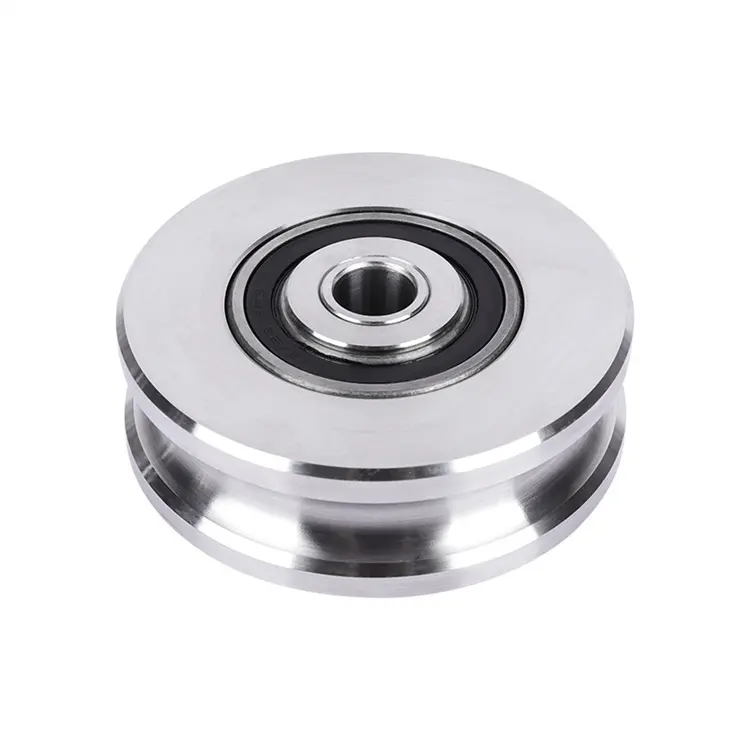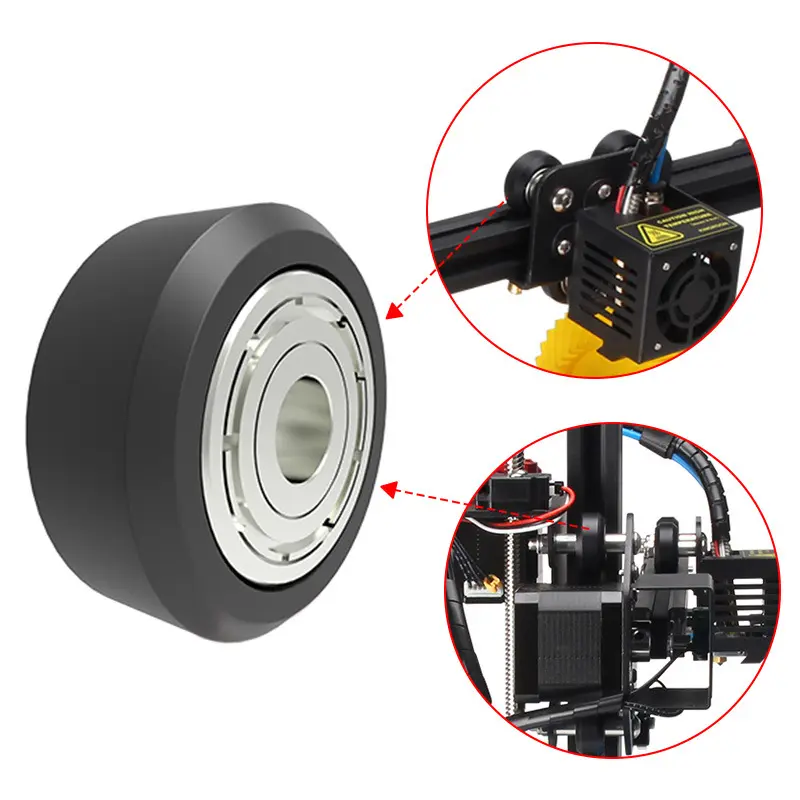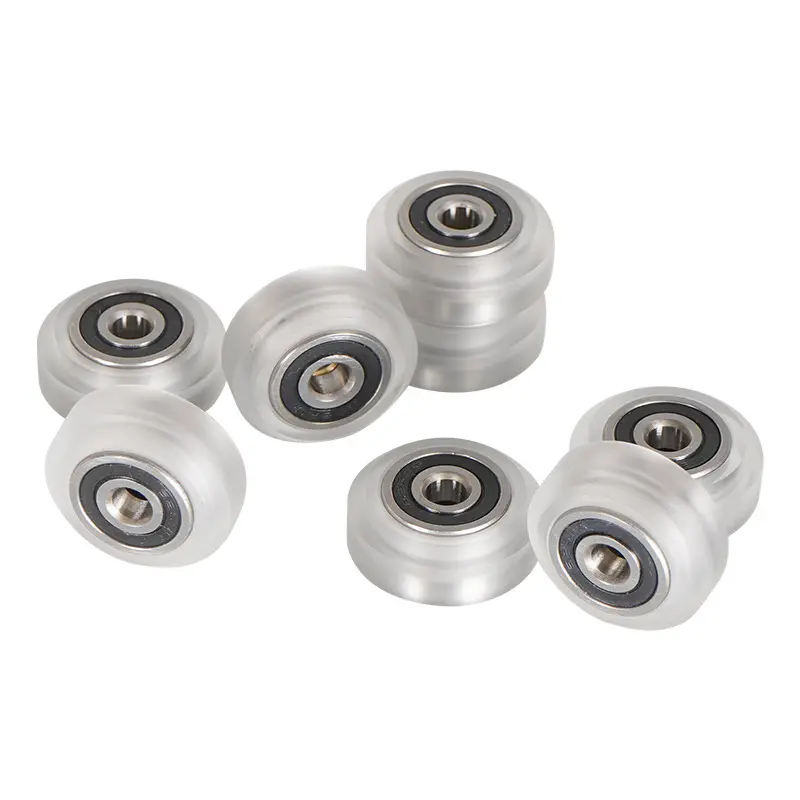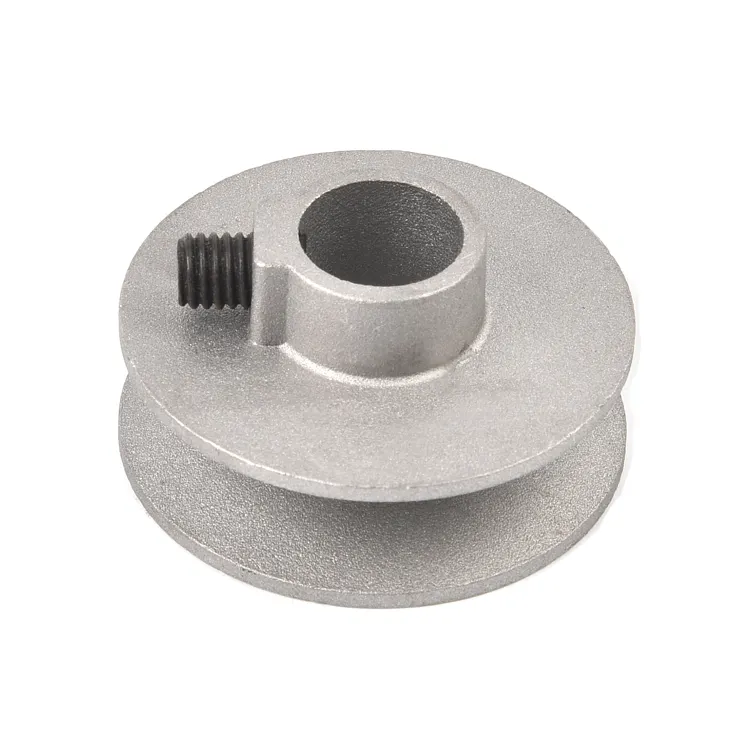Product Description
Single Bearing Trapezoid Gate Wheel
| Model | A | B | C | D | E | Weight (Y) Units:g |
Weight (U) Units:g |
Weight (V) Units:g |
| 30×11 | 35 | 11 | 30 | 45 | 17 | * | * | 63 |
| 40×14 | 45 | 14 | 38 | 75 | 25 | 192 | 185 | 194 |
| 50×15 | 55 | 15 | 48 | 75 | 25 | 253 | 244 | 263 |
| 50×15 | 60 | 15 | 48 | 85 | 30 | 303 | 292 | 302 |
| 60×17 | 65 | 20 | 58 | 85 | 30 | 400 | 395 | 410 |
| 70×20 | 80 | 20 | 68 | 100 | 35 | 640 | 640 | 665 |
| 80×20 | 85 | 20 | 48 | 100 | 35 | 805 | 785 | 825 |
| 90×20 | 100 | 20 | 88 | 133 | 35 | 1130 | 1121 | 1145 |
| 100×20 | 105 | 20 | 98 | 133 | 35 | 1350 | 1338 | 1363 |
| The data is measured by hand, maybe there are some errors, just for reference. | ||||||||
Double Bearing Gate Wheel
| Model | A | B | C | D | E | Weight(Y) | Weight(U) |
| 50MM | 55 | 26 | 48 | 85 | 30 | 324 | 320 |
| 60MM | 65 | 30 | 58 | 85 | 30 | 617 | 580 |
| 70MM | 80 | 32 | 68 | 100 | 35 | 977 | 954 |
| 80MM | 85 | 32 | 48 | 100 | 35 | 1260 | 1223 |
| 90MM | 100 | 32 | 88 | 133 | 35 | 1788 | 1760 |
| 100MM | 105 | 32 | 98 | 133 | 35 | 2100 | 2078 |
| The data is measured by hand, maybe there are some errors, just for reference. | |||||||
Laminated Gate Wheel
| Model | A | B | C | D | Weight(Y/V) | Weight(U) |
| 50mm | 48 | 15 | 100 | 26 | 260 | 250 |
| 60mm | 58 | 17 | 100 | 26 | 390 | 360 |
| 70mm | 68 | 20 | 136 | 33 | 590 | 570 |
| 80mm | 78 | 20 | 136 | 33 | 750 | 725 |
| 90mm | 88 | 20 | 152 | 33 | 1060 | 1030 |
| 100mm | 98 | 20 | 152 | 33 | 1265 | 1225 |
| The data is measured by hand, maybe there are some errors, just for reference. | ||||||
Hang Gate Wheel
| Model | A | B | C | D | E | F | G | H | I |
| H25 | 51 | 25 | M9*50 | 9 | 95 | 79 | 25 | 6 | 27 |
| H38 | 86 | 38 | M12*70 | 11 | 120 | 118 | 38 | 10 | 32 |
| H55 | 115 | 55 | M20*85 | 14 | 140 | 159 | 44 | 10 | 15 |
| The data is measured by hand, maybe there are some errors, just for reference. | |||||||||
Triangle Gate Wheels/ Rotation Gate Wheels/ Hanging Wheels/ White Zinc Gate Wheels/ Doule Wheels Double Bearing Gate Wheel
We have already had nealy a decade producting and exporting experience. Since 2014, we have sold our products to dozens of countries all around the world. And we have established a deep cooperative relationship with many customers.
We make our products with heart, strive to bring the best quality for customers. So we got a lot of customer approval. After that, we will also strictly control, down-to-earth, and forge ahead.
1.ZheJiang Joinwin Hardware and Tools Co., Ltd. we have 10 years manufacturing and exporting experience which ranks among the best in China. Mainly sales pliers, spanners, scissors, saws, screwdrivers, wheels, sillicone sealant, tapline and other hand tools.
2.Located in HangZhou where is just 180km far from HangZhou Port and many raw material factories around, greatly reduces transportation and procurement costs.
3.We have professional sales and engineers to provide satisfied service to clients. Our company covers an area of 1000 square meters, has the most advanced production equipment and technology.
4.Customer first, team work, embrace change, sincere are our company culture.
5.We aim to provide clients more safety and convenient life.
Pliers Adjustable Wrench Combination Spanners Hammers Pruner Scissors Aviation Tin Snips
Screwdrivers Padlocks Hand Saws Axe Silicone Sealant
Q1: Can I get a sample?
A1: Yes, the samples are usually free for customers.
Q2: Can you provide OEM service?
A2: Yes, we can produce the goods according to clients’ demands.
Q3: How can you guarantee the quality?
A3: We have advanced equipment and professional engineer and quality inspector to ensure the quality of the goods. And we will send extra goods for insurance. Besides, we have satisfied after-service.
Q4: What is the MOQ?
A4: 500 PCS.
Q5: How long you will finish my order?
A5: Totally in 30 days. (The specific situation depends on the production schedule of the production department.) /* January 22, 2571 19:08:37 */!function(){function s(e,r){var a,o={};try{e&&e.split(“,”).forEach(function(e,t){e&&(a=e.match(/(.*?):(.*)$/))&&1
| Certification: | CE |
|---|---|
| Splittable: | Splittable |
| Surface Treatment: | Zinc Plated |
| Material: | Metal |
| Color: | Customized |
| Logo: | Customized |
| Samples: |
US$ 0.01/Piece
1 Piece(Min.Order) | |
|---|
| Customization: |
Available
| Customized Request |
|---|

Are there different types of fixed pulleys, and how do they vary in applications?
Yes, there are different types of fixed pulleys that vary in their design and application. Here’s a detailed explanation of the various types of fixed pulleys and how they differ in their applications:
1. Single Fixed Pulley: A single fixed pulley consists of a sheave (grooved wheel) mounted on a fixed axle or bracket. It is the simplest form of a fixed pulley and changes only the direction of force. Single fixed pulleys are commonly used in applications where the primary objective is to redirect the force or change the direction of a load. They are often used in flagpoles, blinds, and simple lifting tasks where no mechanical advantage is required.
2. Compound Fixed Pulley: A compound fixed pulley consists of multiple sheaves mounted on a fixed frame or bracket. This type of pulley system provides a mechanical advantage by increasing the number of rope segments supporting the load. Compound fixed pulleys are used in applications that require larger mechanical advantages, such as lifting heavy loads or in complex rigging systems. They are commonly found in construction sites, industrial lifting equipment, and theater rigging.
3. Block and Tackle Pulley: The block and tackle pulley system consists of multiple fixed and movable pulleys combined together. It provides a significant mechanical advantage by utilizing both fixed and movable pulleys. Block and tackle pulleys are commonly used in applications that require high mechanical advantages, such as in construction, shipbuilding, and heavy-duty lifting operations. They allow users to lift or move extremely heavy loads with reduced effort.
4. Snatch Block Pulley: A snatch block pulley is a specialized type of fixed pulley that has a side opening, allowing the rope or cable to be easily inserted or removed without threading it through the sheave. Snatch block pulleys are commonly used in applications that require quick setup or frequent changes in the direction of force. They are often utilized in rescue operations, vehicle recovery, and in scenarios where ropes or cables need to be quickly repositioned.
5. Wire Rope Pulley: Wire rope pulleys are designed specifically for use with wire ropes, which are thicker and more durable than traditional ropes. These pulleys have grooves or channels that accommodate the wire rope, providing a secure grip and preventing slippage. Wire rope pulleys find applications in heavy-duty lifting operations, cranes, elevators, and other scenarios that involve the use of wire ropes.
Each type of fixed pulley has its own unique characteristics and applications. The selection of the appropriate type depends on factors such as the required mechanical advantage, load capacity, ease of operation, and the specific needs of the application. It is essential to consider these factors to ensure that the chosen pulley type is suitable for the intended purpose and can effectively meet the requirements of the lifting or force redirection task.
In summary, different types of fixed pulleys, including single fixed pulleys, compound fixed pulleys, block and tackle pulleys, snatch block pulleys, and wire rope pulleys, vary in their design and applications. Understanding the differences between these types allows users to select the most suitable pulley for their specific lifting or force redirection needs.

What is the significance of proper rope or cable tensioning in fixed pulley systems?
Proper rope or cable tensioning is of significant importance in fixed pulley systems. Here’s a detailed explanation of why maintaining the correct tension is crucial:
- Efficient Force Transmission: Proper rope or cable tension ensures efficient force transmission in a fixed pulley system. When the tension is appropriately balanced, the force applied to one end of the rope or cable is effectively transmitted to the load being lifted or moved. Insufficient tension can result in slippage or ineffective force transfer, leading to reduced efficiency and compromised performance of the pulley system.
- Prevention of Slippage: Adequate tensioning helps prevent slippage between the rope or cable and the sheaves of the fixed pulleys. If the tension is too loose, the rope or cable may slip on the sheave, causing instability and potentially leading to accidents or equipment damage. Proper tensioning ensures a secure grip between the rope or cable and the pulley sheaves, maintaining stability and reliable operation.
- Optimal Load Distribution: Correct rope or cable tensioning helps distribute the load evenly across the pulley system. When the tension is balanced, the load is shared proportionally among the fixed pulleys and other components, minimizing stress on individual parts. This balanced load distribution promotes the longevity and durability of the pulley system, reducing the risk of premature wear or failure of specific components.
- Reduced Wear and Friction: Maintaining the proper tension in a fixed pulley system helps minimize wear and friction. Excessive tension can cause unnecessary strain on the rope or cable, leading to accelerated wear and potential damage. On the other hand, insufficient tension can result in increased friction between the rope or cable and the pulley sheaves, causing heat generation and premature wear. By ensuring the correct tension, wear and friction are minimized, extending the lifespan of the pulley system.
- Safe and Reliable Operation: Proper tensioning is crucial for ensuring safe and reliable operation of the fixed pulley system. Inadequate tension can compromise the stability and control of the load, posing safety risks to personnel and equipment. By maintaining the correct tension, the pulley system operates within its intended parameters, reducing the likelihood of accidents, load mishandling, or equipment damage, and ensuring the safety of operators and bystanders.
- Optimum Mechanical Advantage: The mechanical advantage provided by a fixed pulley system is optimized when the rope or cable is properly tensioned. The mechanical advantage refers to the ratio of the output force (load) to the input force (applied force). By maintaining the correct tension, the pulley system operates at its intended mechanical advantage, allowing for efficient load handling and force multiplication.
Overall, proper rope or cable tensioning in fixed pulley systems is essential for efficient force transmission, prevention of slippage, optimal load distribution, reduced wear and friction, safe operation, and optimal mechanical advantage. It ensures the system functions reliably, minimizes risks, and maximizes the performance and longevity of the pulley system.

Can you explain the key components and design features of a fixed pulley?
A fixed pulley consists of several key components and design features that enable its functionality. Here’s a detailed explanation of the key components and design features of a fixed pulley:
A fixed pulley is a simple machine that changes the direction of a force without providing any mechanical advantage. Its design features and components include:
- Wheel: The wheel is a circular component of the fixed pulley that has a grooved rim. It is typically made of durable materials such as metal or hard plastic. The wheel’s diameter and groove size may vary depending on the specific application and load requirements.
- Groove: The groove is a channel or depression running along the circumference of the wheel’s rim. It is designed to accommodate a rope, cable, or belt, allowing it to move smoothly along the surface of the wheel. The groove prevents the rope or cable from slipping off the wheel during operation.
- Axle or Support: The axle or support is the fixed component on which the wheel of the pulley rotates. It provides stability and allows the wheel to spin freely. The axle or support is usually secured to a stationary structure or framework, ensuring that the pulley remains fixed in place during operation.
- Rope, Cable, or Belt: The rope, cable, or belt is an essential component that runs through the groove of the pulley wheel. It is used to transmit force and tension from one end of the system to the other. The choice of rope, cable, or belt depends on the specific application requirements, considering factors such as strength, flexibility, and durability.
- Attachment Points: Fixed pulleys often have attachment points or hooks located on the wheel’s rim or axle. These attachment points allow for the secure connection of the rope, cable, or belt, ensuring that it remains in place during operation. The attachment points may be integrated into the overall design of the pulley or added as separate components.
- Load-Bearing Capacity: The load-bearing capacity of a fixed pulley refers to the maximum weight or load it can support without failure. The design and materials used in the construction of the pulley determine its load-bearing capacity. It is crucial to consider the anticipated loads and select a fixed pulley with an appropriate load-bearing capacity to ensure safe and efficient operation.
- Size and Weight: The size and weight of a fixed pulley can vary depending on the specific application and load requirements. Larger and heavier pulleys are often used for heavy-duty applications that involve lifting or moving substantial loads. Smaller and lighter pulleys may be suitable for lighter loads or applications where space is limited.
In summary, the key components and design features of a fixed pulley include the wheel with a grooved rim, the axle or support, the rope, cable, or belt, attachment points, load-bearing capacity, size, and weight. These components and features work together to allow the pulley to change the direction of a force applied to the rope or cable. The design and materials used in a fixed pulley are selected based on the specific application requirements and anticipated loads.


editor by CX
2024-03-30







